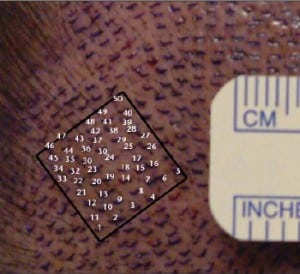 A successful hair transplant depends upon many factors, and one of the most important qualities of a cosmetically beneficial transplant is the ability to achieve adequate follicular unit density with a procedure. In patients who have a sufficient amount of donor hair, follicular unit grafts can be transplanted utilizing high density graft placement techniques, and the end results are more natural and virtually undetectable than less dense procedures.
A successful hair transplant depends upon many factors, and one of the most important qualities of a cosmetically beneficial transplant is the ability to achieve adequate follicular unit density with a procedure. In patients who have a sufficient amount of donor hair, follicular unit grafts can be transplanted utilizing high density graft placement techniques, and the end results are more natural and virtually undetectable than less dense procedures.
To understand the concept of density, one must have some basic knowledge of the scalp. In a human scalp, the average density of hair is around 100 – 125 follicular units in a square centimeter (cm2). Since each follicular unit varies in the number of hairs, studies have shown that about 160 – 250 hairs are present per cm2. When an individual starts to notice their hair loss, they have lost approximately 50% of their hair in that given area.
Even with modern surgical techniques, surgeons are not able to recreate natural hair densities of 125 follicular units/cm2. Fortunately, in order to achieve a cosmetically excellent result, surgeons don’t need to transplant hair at fully natural densities, but they need to be able to transplant the grafts in a high enough density to appear as full as possible.
At the Gabel Hair Restoration Center, Dr. Gabel utilizes several techniques to achieve high-density graft placement. Dr. Gabel and his team utilize high powered stereo-microscopes to meticulously dissect the grafts from the scalp tissue. This magnification allows him to place more follicular unit grafts in a given area. Additionally, if a follicular unit has not been properly trimmed by an experienced hair restoration technician, then high-density graft placement is rendered impossible. Each of Dr. Gabel’s team members has had extensive hands-on training and experience with stereo-microscopes to meet Dr. Gabel’s high standards for follicular unit preparation.
In order to place as many grafts as possible in a given area, Dr. Gabel utilizes custom-sized cut blades that are tailored to an individual’s follicular unit size. Individual follicular units and grafts vary in size from person to person and require customized blades to create the best fit for incision sites.
Therefore, in order to create an opening in the skin to fit an individual’s follicular unit grafts, Dr. Gabel will measure the dimensions of the grafts, and make a blade that perfectly matches the graft size for the specific follicular unit, and avoid unnecessary trauma to the skin while minimizing disruption of the local blood supply in the scalp.
When Dr. Gabel is placing grafts between existing hairs, a custom cut blade allows him to blend the new grafts in a way that achieves higher densities and a more natural result.
There are several different methods to create the openings in the scalp which are used by Dr. Gabel, he predominately utilizes the lateral slit technique to create higher densities for hair transplants, which ultimately achieves a more natural result. The lateral slit technique, also known as the coronal technique, allows Dr. Gabel to have more control during surgery and to place more follicular units in a given space than any other technique. It also allows Dr. Gabel to dictate how the grafts will exit the scalp, which is especially important in the frontal hairline where an acute angle is necessary.
